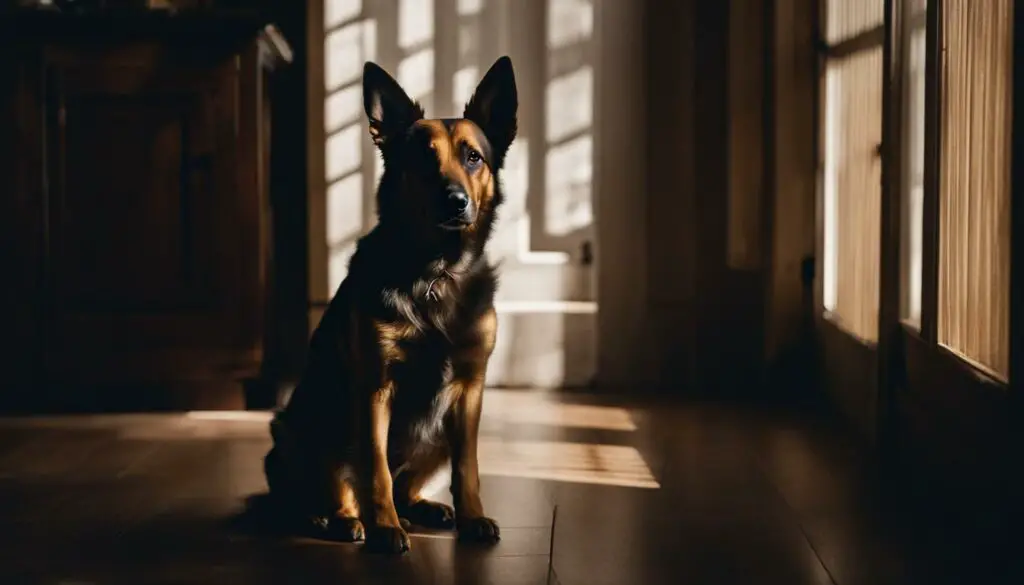Have you ever noticed your dog acting scared for no apparent reason? Dogs can exhibit unexplained fear or anxiety, even when there doesn’t seem to be a visible cause. Understanding and addressing these fears is crucial for the well-being of our furry friends. In this article, I will explore the possible reasons behind a dog’s mysterious fear and discuss ways to help them overcome it.
When your dog starts acting scared, it is important to observe their behavior and try to identify any patterns or triggers. Dogs often display obvious signs of fear, such as barking, staring, and avoiding certain places or objects. By watching their reactions closely, you can gain insights into the potential causes of their fear and take appropriate measures to address it.
Key Takeaways:
- Dogs can exhibit unexplained fear or anxiety, even without a visible cause.
- Observing your dog’s behavior can help identify patterns or triggers of their fear.
- Signs of fear in dogs include barking, staring, and avoidance behaviors.
- Understanding and addressing canine fears is crucial for their well-being.
- Seeking professional help may be necessary in severe cases of dog anxiety.
Interpreting Your Dog’s Fear
When it comes to understanding your dog’s fear, it’s important to pay close attention to their behavior and cues. Dogs have their own unique ways of expressing fear, and by observing these signs, you can gain valuable insights into what may be causing their distress. Here are some common signs of fear in dogs:
- Excessive panting or drooling
- Tail tucked between the legs
- Whining or whimpering
- Attempting to hide or escape
- Showing signs of aggression, such as growling or snapping
These behaviors can vary from dog to dog, so it’s essential to become familiar with your pet’s specific signals. By doing so, you’ll be better equipped to interpret their fear and take the necessary steps to help them feel safe and secure.

Another crucial aspect of interpreting your dog’s fear is identifying any patterns or triggers. Pay attention to the situations, objects, or people that seem to provoke fear in your dog. It could be specific noises, environments, or even certain individuals. By recognizing these triggers, you can work on desensitizing your dog to them or avoiding them altogether to prevent unnecessary distress.
Remember, fear in dogs is a natural response to perceived threats or danger. As their owner, it’s your responsibility to provide a safe and supportive environment where they can feel secure. By understanding and interpreting your dog’s fear, you’ll be better equipped to address their needs and help them overcome their anxieties.
Possible Causes of Dog Fear: Loud Noises and Sounds
Dogs have a keen sense of hearing, and certain loud noises or sounds that are indiscernible to humans can startle and scare them. These can range from sudden bangs like fireworks or thunderstorms to high-pitched frequencies from household appliances or construction work. When dogs are frightened by these sounds, they may exhibit various behaviors such as trembling, panting, pacing, or vocalizing their distress.
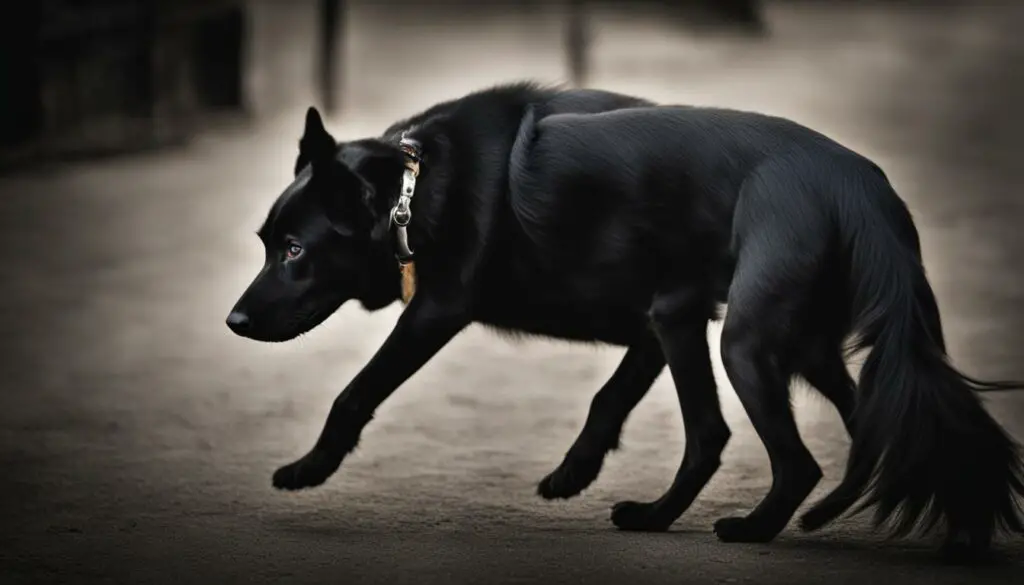
To help dogs cope with their fear of loud noises and sounds, creating a safe and comforting environment is essential. This can include providing a designated hiding place, such as a crate or a quiet room, where they can seek refuge during episodes of heightened anxiety. Additionally, playing soothing music or using white noise machines can help mask the scary sounds and create a more calming atmosphere for the dog.
| Noise/ Sound | Effects on Dogs |
|---|---|
| Fireworks | Trembling, panting, hiding |
| Thunderstorms | Trembling, pacing, vocalizing |
| Household appliances | Startling, hiding, avoidance behavior |
| Construction work | Anxiety, restlessness, pacing |
Gradual desensitization and counter-conditioning techniques can also be employed to help dogs overcome their fear of loud noises and sounds. This involves exposing them to the triggering sounds at a low volume or from a distance, while pairing it with positive experiences such as treats or play to create positive associations. Over time, the dog’s fear response can be minimized, and they can become more comfortable and confident in the presence of these previously scary sounds.
Infestations and Unpleasant Spaces
Dogs can develop fear or anxiety in response to certain environments or spaces that they find unpleasant or associated with negative experiences. This can include areas of the house that have been infested with insects or rodents, causing discomfort and fear in dogs.
When a dog detects an infestation, such as insects or rodents, it can trigger their fear response. Painful insect bites or the presence of crawling creatures can startle and scare them. Dogs may exhibit avoidance behaviors or show signs of uneasiness in these areas.
In addition, certain rooms or spaces like the bathroom or laundry room can be unpleasant for dogs. The loud noises from machines or previous negative experiences in these areas can make them anxious and fearful. Dogs may avoid entering these spaces or display signs of uneasiness when they are in them.
| Signs of Dogs’ Fear of Infestations and Unpleasant Spaces | Ways to Help Dogs Overcome Fear |
|---|---|
|
|
By understanding and addressing a dog’s fear of infestations and unpleasant spaces, pet owners can create a more comfortable and secure environment for their furry companions. With patience, training, and professional guidance, it is possible to help dogs overcome their fears and live a happier, fear-free life.
Unexplained Spooking: One-Off Experiences
There are times when dogs get spooked by unknown incidents, causing them to exhibit fear or anxiety. These one-off experiences can be challenging to trace back to a specific cause, as they often happen suddenly and unexpectedly. It could be a loud noise, a sudden movement, or an event occurring outside of their awareness. Regardless of the exact trigger, it is important to understand that occasional spooking is relatively common in dogs and usually not a cause for concern.
During these one-off experiences, dogs may exhibit signs of fear, such as cowering, trembling, or trying to escape from the perceived threat. Their heart rate may increase, and they may show avoidance behaviors or seek comfort from their human companions. While it can be difficult to determine the exact cause of their fear, the important thing is to provide a calm and reassuring environment for them to help them calm down.
“Dogs can get scared by unexpected events, and it is our role as their caretakers to provide them with support and comfort during these moments.” – Me
If your dog experiences a one-off spooking incident, it is important not to reinforce their fear by coddling or babying them excessively. Instead, try to redirect their attention to something positive, like a favorite toy or treat. Positive reinforcement training can also help build their confidence and resilience over time. If the fear persists or intensifies, it may be helpful to consult with a professional dog behaviorist who can provide guidance and develop a tailored plan to address your dog’s specific needs.
Table: Examples of One-Off Spooking Incidents
| Incident | Description |
|---|---|
| Loud fireworks | A sudden burst of loud fireworks during a walk can startle a dog and cause them to become fearful. |
| Unexpected thunderstorm | The sudden onset of a thunderstorm with loud thunder and bright lightning can trigger fear in dogs. |
| Dropping a loud object | If something heavy and loud accidentally falls near a dog, it can cause them to become spooked and anxious. |
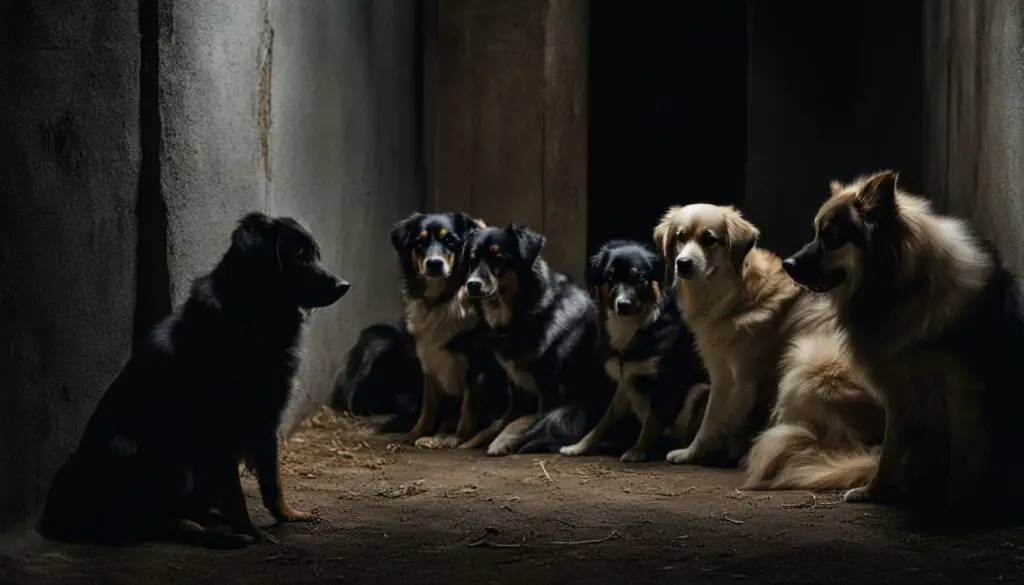
Remember that occasional spooking incidents are a normal part of a dog’s life, and it is essential to provide them with love, support, and a safe environment. By understanding their individual needs and reactions, you can ensure that they feel secure and comforted during these one-off experiences.
Age-Related Cognitive Disorders
As dogs grow older, they can experience age-related cognitive decline, which may include conditions like dementia. Just like humans, older dogs can develop confusion, memory loss, and changes in behavior. These cognitive disorders can also lead to intense fear and anxiety in our furry friends.
It’s important to recognize the signs of cognitive decline in older dogs, as fear and anxiety can be symptoms of these conditions. Dogs with cognitive disorders may display increased restlessness, excessive panting, difficulty sleeping, and a heightened startle response. They may also show signs of disorientation and may become fearful of people or objects that were once familiar to them.
If you suspect that your older dog’s fear is related to cognitive decline, it’s crucial to consult with a veterinarian. The vet can perform a thorough examination to assess your dog’s cognitive function and provide guidance on managing their condition. They may recommend medications, dietary changes, mental stimulation exercises, or other interventions to help alleviate your dog’s fear and anxiety.
| Dog’s Age | Common Symptoms of Cognitive Disorders |
|---|---|
| 8 years and older | Increased restlessness, disorientation, difficulty sleeping, heightened startle response, fear or aggression towards familiar people or objects |
| 10 years and older | Loss of housetraining, decreased interest in food, changes in social interactions, repetitive behaviors |
While we may not be able to cure age-related cognitive disorders in dogs, we can provide them with a safe and comfortable environment. Creating a predictable routine, minimizing stressors, and offering mental and physical stimulation can help improve their quality of life. Additionally, providing gentle reassurance and avoiding situations that may trigger fear or anxiety can go a long way in making your older dog feel secure and loved during this challenging time.
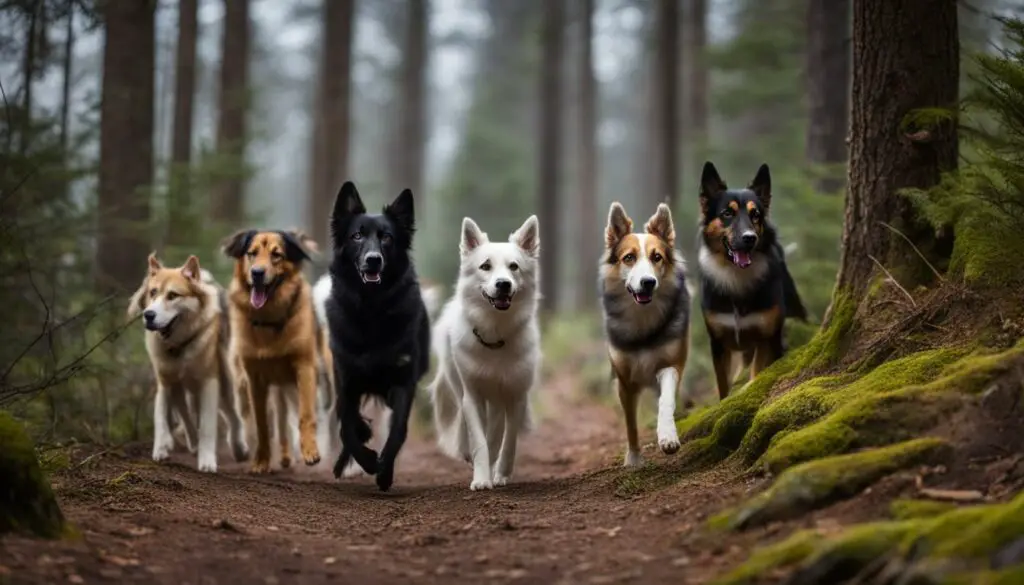
Dogs with Underlying Illnesses: Fear as a Symptom of Illness
When it comes to unexplained fear in dogs, it’s important to consider that it could be a symptom of an underlying illness. Just like humans, dogs can experience fear and anxiety as a result of various health conditions. Identifying and addressing these underlying illnesses is crucial for the well-being of our furry companions.
Some common health-related fears in dogs include vestibular disease, which can cause dizziness and disorientation, leading to increased fear and anxiety. Additionally, certain hormonal imbalances or neurological disorders can also contribute to heightened fear responses in dogs. It’s essential to consult with a veterinarian if you suspect that your dog’s fear is related to an underlying health issue.
By addressing the root cause of their fear, we can take appropriate measures to treat the underlying illness and help alleviate their anxiety. Veterinary guidance and treatment plans can provide valuable insights and help us provide the best care for our dogs.
| Underlying Illnesses | Symptoms |
|---|---|
| Vestibular Disease | Dizziness, loss of balance, disorientation |
| Hormonal Imbalances | Increased fear responses, mood changes |
| Neurological Disorders | Heightened anxiety, abnormal behaviors |
Recognizing that fear can be a symptom of an underlying illness is crucial for effectively addressing and managing our dogs’ anxiety. By seeking veterinary attention and proper diagnosis, we can ensure that our furry friends receive the appropriate treatment and care they need to overcome their fears and lead happy, healthy lives.

Understanding Fear as a Symptom
Fear is the way our dogs communicate that something is not right. By paying attention to their behavior and consulting with a veterinarian, we can identify whether their fear is linked to an underlying illness. It’s important to remember that fear can affect dogs of any age, and timely intervention is key to their well-being.
Recognizing Anxiety in Dogs
Anxiety in dogs is a common issue that can have a significant impact on their well-being. As pet owners, it’s important to be able to recognize the signs of anxiety in our furry friends so that we can provide them with the support and care they need.
One of the key signs of anxiety in dogs is changes in behavior. For example, you may notice that your dog becomes more withdrawn or less interested in activities they used to enjoy. They may also exhibit increased clinginess and seek constant reassurance from their owners.
Other behavioral signs of anxiety in dogs include excessive barking or whining, panting, pacing, and trembling. Dogs with anxiety may also display destructive behaviors, such as chewing on furniture or excessive digging.
If you notice any of these signs in your dog, it’s important to consult with a veterinarian or a certified animal behaviorist. They will be able to provide a proper diagnosis and develop a tailored treatment plan to help alleviate your dog’s anxiety.
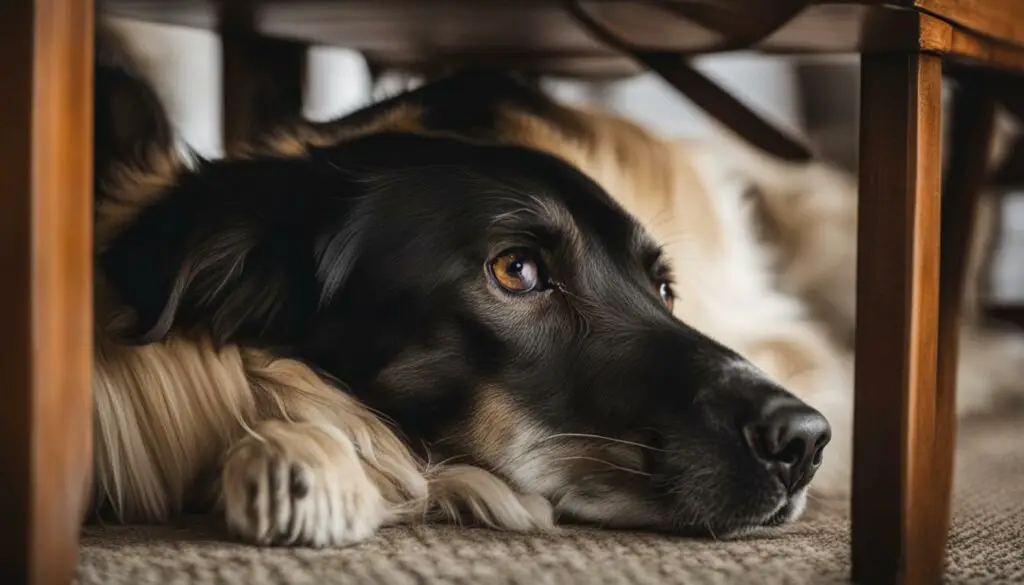
Signs of Anxiety in Dogs:
- Changes in behavior, such as withdrawal or clinginess
- Excessive barking or whining
- Panting, pacing, and trembling
- Destructive behaviors, such as chewing or digging
“Recognizing the signs of anxiety in dogs is the first step in helping them feel more secure and content.”
Distinguishing Fear, Phobia, and Anxiety in Dogs
Understanding the differences between fear, phobia, and anxiety is essential for addressing and managing canine fears effectively. While these terms are related, they encompass distinct aspects of a dog’s emotional state and behavior.
Fear is a natural response to an immediate threat or perceived danger. It is a temporary emotional state, often triggered by specific stimuli such as loud noises or unfamiliar objects. When a dog is afraid, they may exhibit signs like trembling, hiding, or seeking comfort from their owner.
Phobia is an extreme and persistent fear response to a specific trigger. Unlike fear, which typically subsides when the threat is removed, a phobia can persist even in the absence of the trigger. For example, a dog with a phobia of thunderstorms may experience intense anxiety and panic during a storm regardless of their environment.
Anxiety is a recurring or continuous state of unease and apprehension. Unlike fear and phobia, which are often related to specific triggers, anxiety may manifest as generalized feelings of fear and worry. Dogs with anxiety may exhibit behaviors like excessive whining, pacing, or compulsive licking.
| Fear | Phobia | Anxiety |
|---|---|---|
| A natural response to immediate threats or perceived danger | An extreme and persistent fear response to a specific trigger | A recurring or continuous state of unease and apprehension |
| Temporary emotional state | Can persist even in the absence of the trigger | May manifest as generalized feelings of fear and worry |
| Triggered by specific stimuli | Triggered by a specific trigger or situation | May not have a specific trigger |
By understanding the distinctions between fear, phobia, and anxiety, dog owners can approach their furry friends’ fears with empathy and develop appropriate strategies to help them feel safe and secure.
Preventing Fears and Phobias in Dogs
Preventing fears and phobias in dogs is essential for their overall well-being and happiness. By taking proactive measures and providing proper socialization, we can help our furry friends develop resilience and reduce the likelihood of fear-related issues. Let’s explore some effective strategies for preventing dog fears and promoting a positive environment.
Socialization for Dogs
Socialization plays a crucial role in preventing fears and anxieties in dogs. It involves exposing puppies and young dogs to various experiences, environments, and stimuli in a positive and controlled manner. By gradually introducing them to different people, animals, sounds, and situations, we can help them build confidence and develop a well-rounded personality.
During the critical socialization period, which is typically between 3 to 14 weeks of age, it is important to expose puppies to a wide range of experiences while ensuring their safety and comfort. This can include gentle handling, meeting new people and animals, exploring different surfaces, and gradually introducing them to new environments.
Continued socialization throughout a dog’s life is equally important. Taking them on regular outings to new places, allowing them to interact with different people and animals, and exposing them to various sounds and stimuli can help prevent the development of fears and anxieties. It is crucial to ensure that these experiences are positive and enjoyable for the dog, using rewards, praise, and reassurance to create a sense of confidence and security.
| Benefits of Socialization for Dogs | Examples of Socialization Experiences |
|---|---|
| Develops confidence and resilience | Visiting parks and dog-friendly establishments |
| Reduces the likelihood of fear-related issues | Attending obedience classes or training sessions |
| Promotes positive interactions with people and animals | Organizing playdates with friendly, well-behaved dogs |
| Allows dogs to adapt to different environments and stimuli | Exposing them to different sounds, sights, and surfaces |
Remember, socialization should always be a positive and gradual process. Each dog is unique, and it’s important to respect their individual comfort levels and preferences. If your dog shows signs of fear or anxiety during socialization, consult with a professional dog trainer or behaviorist for guidance.
By prioritizing socialization and providing positive experiences for our dogs, we can help them develop into confident, well-adjusted companions. Preventing fears and phobias in dogs is a lifelong commitment that requires patience, consistency, and love. Together, let’s create a nurturing environment where our furry friends can thrive and live fear-free lives.
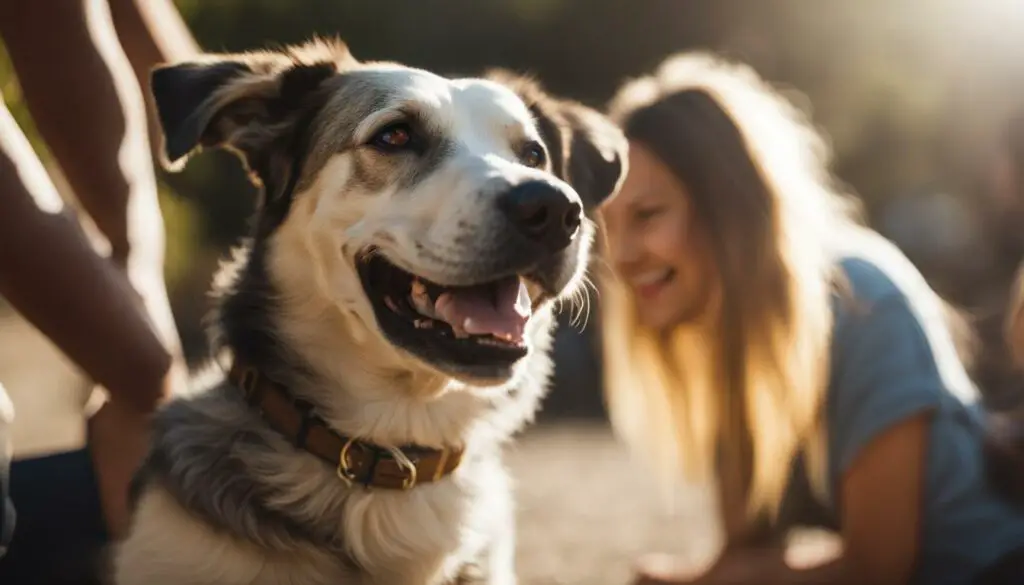
Strategies to Help Dogs with Anxiety
If your dog is experiencing anxiety, there are several strategies you can implement to help them feel more calm and secure. Creating a safe and comforting environment is essential, as it provides them with a sense of security. Set up a dedicated space for your dog where they can retreat to when they feel anxious. This can be a crate, a cozy corner with their favorite bed, or a quiet room where they can relax.
Mentally stimulating activities can also be effective in reducing anxiety. Engage your dog in puzzle toys, interactive games, or training exercises that challenge their mind and redirect their focus away from their anxieties. These activities not only provide mental stimulation but also help in building their confidence and teaching them new skills.
There are various products available in the market that can aid in managing anxiety in dogs. Furniture-style enclosed crates provide a den-like space for dogs to retreat to, mimicking the natural instinct of finding shelter. Calming treats and supplements, formulated with ingredients like chamomile and lavender, can help promote relaxation. Additionally, interactive toys designed to keep dogs occupied and mentally engaged can help alleviate anxiety.
It is important to note that each dog is unique, and what works for one may not work for another. If your dog’s anxiety is severe or persistent, it is recommended to consult with a veterinarian or a professional dog behaviorist. They can provide personalized guidance and suggest specific techniques or therapies to help your dog manage their anxiety and improve their overall well-being.
| Strategies to Help Dogs with Anxiety | Benefits |
|---|---|
| Create a safe and comforting environment | Provides a sense of security |
| Engage in mentally stimulating activities | Redirects focus and builds confidence |
| Use products like furniture-style enclosed crates, calming treats, and interactive toys | Aids in relaxation and provides mental stimulation |
| Consult with a veterinarian or professional dog behaviorist | Personalized guidance and specific techniques or therapies |
The Impact of Fear on Dogs and Their Behavior
Fear and anxiety can have a significant impact on a dog’s behavior and overall well-being. When dogs experience intense fear, it can lead to various negative consequences, including fear-related aggression, destructive behaviors, and even physical and emotional health decline. Understanding these impacts is crucial for addressing their fears and providing the necessary support and guidance.
Fear-related aggression is one of the most concerning consequences of fear in dogs. When a dog is fearful, they may exhibit aggressive behaviors as a defense mechanism. This can include growling, lunging, or even biting. It is important to address fear-related aggression promptly to ensure the safety of both the dog and those around them. Consulting with a qualified dog trainer or behaviorist can help develop a tailored behavior modification plan to manage and reduce fear-related aggression.
In addition to aggression, fear and anxiety can also manifest in destructive behaviors. Dogs may chew on furniture, dig holes in the yard, or engage in excessive barking or howling when they are fearful. These behaviors can be a result of trying to relieve their anxiety or redirect their fear onto objects. Providing appropriate mental and physical stimulation, as well as creating a positive and secure environment, can help alleviate these destructive behaviors.
Furthermore, fear and anxiety can take a toll on a dog’s overall well-being. Dogs that are constantly fearful or anxious may experience chronic stress, which can negatively impact their immune system, digestion, and overall health. It is essential to address the underlying causes of fear and anxiety to prevent this decline in physical and emotional well-being. By implementing calming techniques, creating a safe environment, and seeking professional help when needed, we can help our dogs lead happier and healthier lives.
| Consequences of Fear in Dogs | Impact |
|---|---|
| Fear-Related Aggression | Can lead to dangerous situations and harm to humans or other animals |
| Destructive Behaviors | Can result in damage to property and create a stressful environment for both the dog and their owners |
| Decline in Health | Chronic stress and anxiety can lead to various health issues, weakening the overall well-being of the dog |
Fear as a Reaction and Attraction
Fear is a powerful emotion that not only affects the individual experiencing it but also has an impact on others. In the animal kingdom, fear signals can attract fear in others, creating a chain reaction of fearful behavior. Dogs, like many other animals, are highly attuned to the emotional states of their counterparts, and when they sense fear, they may respond with fear as well. This can create a cycle where fear spreads from one individual to another, intensifying the overall level of fear in a group or community.
When a fearful dog encounters another fearful dog, their fear-based reactions can amplify each other, making the situation more challenging to manage. This phenomenon is known as fear attraction. It highlights the contagious nature of fear and the importance of addressing and transforming fear in order to break the cycle.
Fear can have a ripple effect, like a pebble dropped into a calm pond. It can quickly spread and influence the behavior of those around it. By understanding fear attraction and its impact on animals, we can take steps to create a more positive and fear-free environment for our dogs.
Preventing fear-based reactions in animals requires a multi-faceted approach. It begins with recognizing and addressing the individual fears of each dog, providing them with the necessary support and tools to overcome their anxiety. Additionally, creating a calm and secure environment by reducing potential triggers and offering positive experiences can help dogs feel more at ease and less prone to fear-based reactions.
By breaking the cycle of fear through understanding, compassion, and proactive measures, we can create a harmonious environment where dogs and other animals can thrive without the burden of fear.

Fear’s Blinding Nature
Fear has a profound impact on our perception and focus, often blinding us to everything except the immediate threat or source of fear. This narrowing of attention applies not only to humans but also to our canine companions. When dogs are overwhelmed by fear, their focus becomes solely centered on self-preservation, causing them to miss out on important details and stimuli in their surroundings.
The influence of fear on perception can be detrimental in several ways. For example, a dog that is fearful of other dogs may become fixated on potential threats and miss the opportunity to socialize and form positive relationships. Additionally, fear can distort how a dog perceives certain situations, leading them to overreact or exhibit defensive behavior when there is no real danger present.
To overcome fear’s blinders, it is essential to recognize the limitations that fear imposes and actively work towards expanding our perception. This can be achieved through positive reinforcement training techniques, gradual desensitization to fear triggers, and providing a calm and supportive environment. By helping our dogs build confidence and trust, we can encourage them to focus on the present moment and gradually expand their awareness beyond their immediate fears.
| Fear’s Impact on Perception | Fear’s Influence on Focus | Overcoming Fear’s Blinders |
|---|---|---|
| Fear narrows our focus, blinding us to other aspects of our surroundings. | Fear can cause dogs to become fixated on the perceived threat, missing out on other important stimuli. | Recognize the limitations of fear and actively work towards expanding perception through training and desensitization techniques. |
| Fear can distort how we perceive certain situations, leading to overreactions or defensive behavior. | Fear can prevent dogs from socializing and forming positive relationships. | Provide a calm and supportive environment, helping dogs build confidence and trust. |
Overcoming fear’s blinders requires patience, understanding, and consistent effort. By helping our dogs feel safe and supported, we can empower them to navigate the world with greater confidence and resilience.
Conclusion
Understanding our dogs’ fears and anxieties is essential for providing them with a safe and happy life. Whether their fear is triggered by specific stimuli, underlying illnesses, or generalized anxiety, we have the power to support them in overcoming these challenges.
By recognizing the signs of fear and anxiety in our dogs, we can take proactive measures to mitigate their distress. This includes observing their behavior, identifying triggers, and creating a comforting environment. Additionally, seeking professional help, such as consulting with a veterinarian or a qualified dog trainer, can provide valuable guidance in managing their fears.
Prevention is key when it comes to canine fears. By socializing puppies and young dogs, exposing them to various environments and stimuli, we can help build their resilience and reduce the likelihood of fear-related issues in the future.
Overcoming fear requires patience, understanding, and love. By choosing love over fear, we can create a harmonious and peaceful environment for our furry companions, allowing them to live their lives free from unnecessary distress. Together, we can help our dogs overcome their fears and improve their overall well-being.
FAQ
What are the signs of fear in dogs?
Signs of fear in dogs can include barking, staring, avoidance behaviors, and pacing.
Why are dogs scared of loud noises?
Dogs have sensitive hearing and can be startled or scared by loud noises that humans can’t hear.
Why do dogs avoid certain rooms or spaces?
Dogs may avoid certain rooms or spaces due to previous negative experiences or loud noises from machines.
What causes a dog’s fear of unknown incidents?
Dogs can become scared by one-time events or experiences, even if the original cause is unknown.
How does age-related cognitive decline affect a dog’s fear?
Older dogs with cognitive disorders may experience intense fear or anxiety due to confusion and hallucinations.
Can fear be a symptom of an underlying illness?
Yes, various illnesses and conditions can manifest as fear or anxiety in dogs.
What are the signs of anxiety in dogs?
Signs of anxiety in dogs can include tail tucking, avoiding eye contact, pacing, licking, and displacement behaviors.
How are fear, phobia, and anxiety different?
Fear is a natural response to immediate threats, phobia is an extreme fear response to a specific trigger, and anxiety is a recurring state of unease and apprehension.
How can fears and phobias be prevented in dogs?
Proper socialization and exposure to different stimuli during the critical socialization period can help prevent fears and phobias in dogs.
What strategies can help dogs with anxiety?
Creating a calming environment, providing a private space, engaging in mentally stimulating activities, and using products like enclosed crates and calming treats can aid in managing anxiety in dogs.
What are the consequences of fear on a dog’s behavior?
Unaddressed fear can lead to aggression, destructive behaviors, and a decline in a dog’s physical and emotional health.
How does fear attract fear in dogs and other animals?
Dogs and other animals respond to fear signals from others, creating a cycle of fearful behavior.
How does fear limit a dog’s perception?
Fear narrows a dog’s focus and perception, making it difficult for them to see beyond the immediate threat or source of fear.
Source Links
- https://www.hepper.com/why-is-dog-suddenly-scared-of-something-in-the-house/
- https://www.pethub.com/articles/242692/recognizing-abnormal-canine-stress-and-dog-anxiety
- https://medium.com/illumination/the-lessons-i-learned-from-walking-a-terrified-poodle-6f7c319fd232

